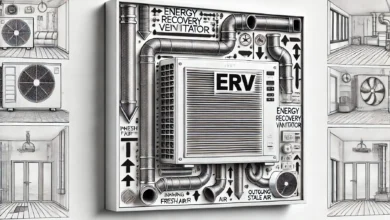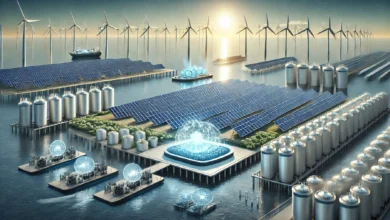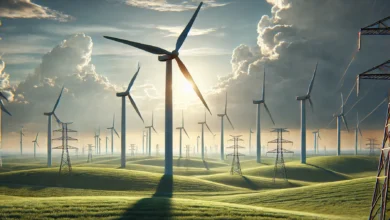Home Wind Turbines: Is It a Smart Investment?

Home wind turbines have gained popularity as more homeowners seek sustainable and renewable energy solutions. They promise to reduce electricity bills, lessen carbon footprints, and contribute to a greener future. But are they truly worth the investment? This comprehensive guide will break down everything you need to know about Home Wind Turbines, how they work, their costs, benefits, and whether they’re a viable option for your home.
Contents
- 1 Where Residential Wind Power Could Make Sense
- 1.1 Home Wind Turbine Cost (2025)
- 1.2 Are Home Wind Turbines Worth It?
- 1.3 Comparing Home Wind Turbines to Other Renewable Energy Sources
- 1.4 Financial Incentives and Rebates
- 1.5 How Big of a Wind Turbine Do You Need to Power a House?
- 1.6 Can I Put a Wind Turbine on My House?
- 1.7 Types of Home Wind Turbines
- 1.8 Safety Considerations for Home Wind Turbines
How Home Wind Power Generation Works?
Home wind turbines generate electricity by harnessing the kinetic energy from the wind. When wind flows over the turbine’s blades, it causes them to spin. This rotational energy turns a generator, producing electricity that can be stored or directly used to power your home. To give you a better idea, let’s consider a real-world example.
In coastal areas of California, homeowners have successfully installed small wind turbines to generate supplemental power for their properties. With consistent winds averaging above 5 mph, these systems have proven efficient, providing significant energy savings over time. The primary components of these systems include rotor blades, a shaft, a generator, an inverter, a battery, and a controller. These elements work together to capture, convert, and distribute wind energy effectively.
Practical Examples and Use Cases
- Texas Ranches: In rural areas of Texas, large properties often utilize home wind turbines to generate power for both homes and agricultural operations. This approach reduces energy costs significantly and offers a reliable source of power during grid outages.
- UK Coastal Homes: Along the coast of Scotland, wind turbines are popular due to consistently high wind speeds. Homeowners who have adopted these systems report substantial reductions in their electricity bills.
- California Hybrid Systems: In Northern California, combining wind turbines with solar panels has proven highly effective. Homeowners report energy efficiency improvements of nearly 30% when compared to single-source systems.
- Off-Grid Cabins in Alaska: In remote areas with no access to the grid, homeowners have installed wind turbines as part of off-grid systems to provide continuous power throughout harsh weather conditions.
Where Residential Wind Power Could Make Sense
Residential wind power can be an effective renewable energy solution, but it’s only practical for properties that meet certain criteria. Ideally, the location should be windy, rural, and have high energy consumption to justify the investment in a wind turbine.
Windy

The most critical factor for successful residential wind power generation is wind availability. Properties located in areas with average wind speeds above 10 or 11 miles per hour (4.5 to 5 meters per second) are more likely to benefit from wind power systems. The higher the wind speed, the greater the power generation.
Using tools like the National Oceanic and Atmospheric Administration’s (NOAA) wind maps is an effective way to gauge average wind speeds throughout the year. These maps offer month-by-month breakdowns of wind patterns across the country, helping homeowners determine if their location is suitable for wind power. Additionally, professional turbine installers can assess whether your site consistently receives enough wind to significantly reduce your electric bill.
Rural

Rural areas are generally more favorable for residential wind power systems due to the availability of wide-open spaces free from tall obstructions like buildings or trees. For optimal performance, a wind turbine should be mounted at least 30 feet above any nearby structures or natural obstacles.
Moreover, zoning regulations and permitting requirements vary by state and municipality. However, denser areas often pose more challenges for installation, including restrictions related to noise, aesthetics, and proximity to neighboring properties. For example, suburban communities with one-acre lots may find it nearly impossible to gain approval for a turbine installation.
High Electricity Consumption
Residential wind turbines are typically most beneficial for properties with significant energy needs. Unlike solar power, which is highly customizable and scalable, wind turbines generally come in predefined sizes. This makes them more suitable for large homes or properties with high electricity consumption.
For households with modest energy needs, the investment in a wind turbine may not be financially practical. However, for properties requiring substantial power, particularly those in windy rural areas, residential wind power can be a worthwhile and efficient investment.
Home Wind Turbine Cost (2025)

Investing in a Home Wind Turbine can be a significant financial commitment. The total cost depends on various factors such as the turbine’s size, type, installation complexity, and location. While the initial investment can be substantial, potential savings over the long term often justify the expense.
Smaller systems designed for residential use typically range from $4,000 to $15,000 for systems generating between 1 and 5 kW. Medium-sized systems, capable of producing 5 to 20 kW, generally cost between $15,000 and $40,000. Larger systems exceeding 20 kW are usually priced at $40,000 or more.
Apart from installation costs, homeowners should also account for ongoing maintenance expenses, which typically range from $100 to $500 annually. Maintenance includes regular inspections, repairs, and potential part replacements to ensure efficient operation.
The good news is that various financial incentives are available in the U.S., including federal tax credits covering up to 30% of installation costs. Additionally, many states offer specific rebates and grants, particularly in areas with strong renewable energy initiatives like California, Texas, and New York.
Home Wind Turbine Cost Breakdown
| Turbine Type | Capacity (kW) | Cost Range (USD) | Description |
|---|---|---|---|
| Small Wind Turbines | 1 – 5 | $4,000 – $15,000 | Suitable for small homes and cabins. |
| Medium-Sized Turbines | 5 – 20 | $15,000 – $40,000 | Ideal for larger homes or small farms. |
| Large Wind Turbines | 20+ | $40,000+ | Designed for large estates or multiple properties. |
| Annual Maintenance Cost | Varies | $100 – $500 | Regular checks and repairs required. |
| Federal Tax Incentives | N/A | Up to 30% Off | Available for installation costs. |
| State-Specific Rebates | N/A | Varies | Additional savings depending on location. |
By understanding these costs and available incentives, homeowners can better determine whether a Home Wind Turbine is a worthwhile investment for their specific needs and location.
Are Home Wind Turbines Worth It?
Evaluating the worth of Home Wind Turbines involves examining several factors such as location, costs, environmental benefits, and maintenance requirements. Areas with consistent wind speeds above 5 mph are ideal for generating sufficient electricity. The initial investment can be high, but long-term savings often outweigh these costs, particularly in coastal regions and open rural areas where payback periods of approximately 6-10 years are common. Using wind energy also reduces carbon emissions and dependency on fossil fuels, contributing positively to the environment.
Pros and Cons of Home Wind Turbines
Pros:
- Renewable and clean energy source
- Potential to lower electricity bills
- Low environmental impact
- Energy independence
Cons:
- High upfront costs
- Noise and aesthetic concerns
- Intermittent power generation depending on wind availability
- Maintenance requirements
Home Wind Turbines vs Solar Panels
When it comes to choosing the most efficient renewable energy solution for your home, the debate between Home Wind Turbines and Solar Panels often arises. Both technologies offer clean energy, but their suitability depends on factors such as location, climate, cost, maintenance, and energy generation capacity. Below is a detailed comparison between these two technologies.
| Aspect | Home Wind Turbines | Solar Panels |
|---|---|---|
| Efficiency | High in windy areas, especially coastal or open rural regions. | High in sunny areas with consistent sunlight exposure. |
| Cost | Moderate to High; installation ranges from $4,000 to $40,000 depending on size. | Moderate; installation costs generally range from $10,000 to $30,000. |
| Maintenance | Requires regular maintenance, especially in areas with extreme weather. | Low maintenance; occasional cleaning and inspection required. |
| Environmental Impact | Zero emissions; may pose minor threats to birds. | Zero emissions; minimal environmental impact. |
| Installation Flexibility | Limited by zoning and wind availability. | Highly flexible; can be installed on rooftops, ground, or even portable setups. |
| Energy Generation | Works day and night, especially effective during windy seasons. | Generates energy only during daylight hours; reduced output during cloudy or rainy days. |
| Longevity | Generally lasts 20-25 years with proper maintenance. | Can last 25-30 years with minimal maintenance. |
Key Takeaways:
- Home Wind Turbines excel in windy areas and offer continuous power generation even during nighttime.
- Solar Panels are ideal for areas with consistent sunlight and offer high installation flexibility.
- A Hybrid System combining both technologies can maximize energy efficiency and reliability.
Comparing Home Wind Turbines to Other Renewable Energy Sources
Exploring how Home Wind Turbines compare to other renewable energy options can help make an informed decision. Compared to solar panels, wind turbines often produce more energy during night hours and colder seasons. Combining wind and solar power through hybrid systems has become increasingly popular, especially in regions like Northern California, where hybrid installations have resulted in nearly 30% higher energy efficiency than using a single renewable source.
Comparison of Different Renewable Energy Sources
| Aspect | Home Wind Turbines | Solar Panels | Hydropower | Biomass Energy |
|---|---|---|---|---|
| Efficiency | High in windy areas | High in sunny areas | Very high if near water sources | Moderate; depends on feedstock quality |
| Cost | Moderate to High | Moderate | High (infrastructure) | Moderate |
| Maintenance | Regular maintenance | Low | High (dams, turbines) | Moderate |
| Environmental Impact | Zero emissions, minor wildlife disruption | Zero emissions | Habitat alteration, possible fish disruption | Carbon-neutral but requires land use |
| Installation Flexibility | Limited by zoning | High flexibility | Limited to water bodies | Flexible, depending on feedstock availability |
| Energy Generation | Day and night operation | Only during daylight | Continuous if water flow is constant | Continuous depending on supply |
Financial Incentives and Rebates
Financial incentives can significantly impact the viability of Home Wind Turbines. In the U.S., federal tax credits covering up to 30% of installation costs are available for homeowners investing in renewable energy solutions. Some states, particularly those with ambitious renewable energy targets like California, Texas, and New York, also offer rebates and grants. Estimating payback periods and assessing long-term savings are essential steps in determining whether these incentives make the investment worthwhile.
Financial Analysis
| Cost Aspect | Average Cost Range (USD) | Description |
|---|---|---|
| Initial Installation | $4,000 – $40,000 | Varies by size and type of turbine |
| Maintenance | $100 – $500 annually | Regular checks and repairs |
| Federal Incentives | 30% of installation costs | Available as tax credits |
| State Rebates | Varies by location | Specific programs per state |
How Big of a Wind Turbine Do You Need to Power a House?
The size of the Home Wind Turbine you need depends on your household’s energy consumption and local wind speeds. For example, a family living in a medium-sized house in coastal Maine with consistent high wind speeds found that a 10 kW turbine sufficiently met their energy needs.
| House Size | Average Monthly Consumption (kWh) | Recommended Turbine Capacity (kW) |
|---|---|---|
| Small (1,000 sq ft) | 500 – 800 | 2 – 5 |
| Medium (2,000 sq ft) | 800 – 1,200 | 5 – 10 |
| Large (3,000 sq ft) | 1,200 – 2,000 | 10 – 20 |
Can I Put a Wind Turbine on My House?
Installing a Home Wind Turbine on your property is possible, but certain considerations must be addressed. Local zoning laws and building permits can affect whether you can install a turbine. For example, urban areas may impose restrictions due to noise or visual impact concerns, while rural areas tend to have fewer regulatory hurdles. Ensuring your property can support the turbine is another crucial factor to consider.
Types of Home Wind Turbines
Various types of Home Wind Turbines are available, each with unique advantages. Choosing the right type depends on your location, energy needs, and preferences. Here are the most common options:
- 1. Horizontal-Axis Wind Turbines (HAWT):
- The most common and efficient type.
- Best suited for open spaces with consistent wind flow.
- High energy output, especially when installed on towers or poles.
- Commonly used in rural and coastal areas.
- 2. Vertical-Axis Wind Turbines (VAWT):
- Ideal for urban areas with turbulent and unpredictable wind conditions.
- Can capture wind from any direction, making them versatile for city environments.
- More compact and generally quieter than horizontal-axis turbines.
- Lower efficiency compared to HAWTs but suitable for areas where space is limited.
- 3. Rooftop Wind Turbines:
- Designed for installation on buildings and rooftops.
- Compact and accessible, making them an attractive option for urban settings.
- Typically less efficient than larger systems due to size limitations and turbulent airflows.
- Can be combined with solar panels for hybrid energy solutions.
Safety Considerations for Home Wind Turbines
Understanding the safety aspects of Home Wind Turbines is essential. From structural integrity to noise control, each factor requires careful assessment. Ensuring your property can support the weight and force of a turbine is crucial, as is proper grounding to prevent lightning damage. Noise control is another consideration, especially if local regulations restrict sound levels. Regular maintenance also plays a vital role in preventing malfunctions and ensuring safety. For example, rural homeowners in Texas have found that inadequate maintenance often leads to mechanical failures, emphasizing the need for regular checks.



